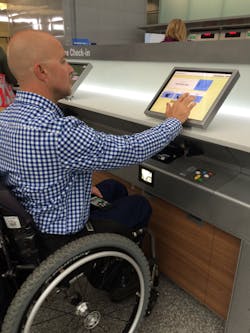For even the most seasoned travelers, the airport experience can be extremely overwhelming. Stressors such as confusing wayfinding and last-minute flight changes are taxing enough for “able-bodied” travelers, let alone older flyers and people with disabilities. As a traveler who is blind, Pat Pound knows all too well the challenges these user groups face when navigating the airport environment, spending considerably more time and energy than her sighted peers gathering information, packing for her faithful guide dog Iris, and setting up the airline ground services she needs. I recently had the pleasure of working with Pat on the Transportation Research Board’s ACRP Research Report 177: Enhancing Airport Wayfinding for Aging Travelers and Persons with Disabilities—a practical guidebook to help airports improve pedestrian wayfinding systems so older adults and persons with diverse abilities can travel independently. Developed with travelers like Pat in mind, the objective of the guidebook is to assist airports in successfully communicating information to these user groups to help them find their way in the airport environment using the principles of universal design.
In order to achieve this objective, however, an airport has to consider far more than just helping people with cognitive, sensory or mobility challenges know where to go. Unless a comprehensive list of considerations is addressed, passengers with diverse abilities will encounter issues that affect their ability to travel independently regardless of their wayfinding abilities — and that is where ACRP Research Report 177 comes in. In this article, I explore how the guidebook offers real benefit to the industry by empowering airports to develop best practices to effectively accommodate the wayfinding needs of aging travelers and persons with disabilities, helping Pat’s dream become a reality.
Applying the Principles of Universal Design
Independent travel in airports for older adults and people with disabilities such as low vision, mobility limitations or problems with short-term memory presents complex navigational challenges in complex spaces that are not easily met by using typical approaches to wayfinding and signage. Reports submitted to Congress by the U.S. Department of Transportation reveal that disability-related air travel complaints involving all air carriers increased by a staggering 139 percent during the 10-year period from 2004 to 2014. This clearly demonstrates that additional efforts are needed to enable airports to help these user groups travel independently and perhaps most importantly with dignity.
As disability categories include blind and low vision, deaf and hard of hearing, ambulatory and non-ambulatory, and intellectual disabilities such as autism and dementia, it is important to understand that each person with a disability is an individual with unique needs. For example, the needs of a traveler with late-onset vision loss will be different from someone born partially sighted, even though their visual acuity is essentially identical. Coping skills, psychological makeup and past travel experiences also play a role. Because of these individual differences, the primary focus must be on creating universal accessibility, enabling wayfinding for all travelers regardless of ability, rather than meeting the assumed needs of a general disability type.
The principles of universal design guide the design of products and environments to make them usable by all people, to the greatest extent possible, without the need for adaptation or specialized design. By paying attention to the needs of persons with disabilities and applying the principles of universal design in all new construction, expansion and renovation projects — from the very beginning of the planning and design process — an airport will enhance the overall wayfinding experience for its customers while reducing the need for specialized services and facilities.
The seven principles of universal design, developed by the Center for Universal Design at North Carolina State University, are in common use worldwide and are especially applicable to airports where the customer base is not only diverse in terms of age and abilities but is likely to be experiencing the airport as an unfamiliar user. While legal accessibility standards are minimum requirements designed to eliminate physical barriers for people with disabilities, universal design — also known as inclusive design, design-for-all, and human-centered design — seeks to provide improved usability and safety for all members of the community and addresses the needs of disability groups not covered by ADA Standards. For instance, applying universal design principle No. 2, Flexibility in Use, is a best practice for airports as it accommodates a wide range of individual preferences and abilities. A good example of this principle in action is the new common-use self-service kiosks designed in-house at San Francisco International Airport that allow both standing and seated users to input information in a variety of ways—from scanning a passport to typing on a touchscreen. Additionally, an audio jack allows blind travelers to receive instructions verbally. The self-service kiosks also illustrate universal design principle No. 1, Equitable Use, as all six stations are accessible.
Wayfinding Strategies via Visual, Verbal and Virtual Communication
A vital component of ACRP Research Report 177 is outlining how airports and airlines can utilize wayfinding strategies in each passenger journey segment. The guidebook identifies the “3 V’s” of communication — visual, verbal and virtual — and how they apply to the target audience. As part of ACRP Research Report 161: Guidelines for Improving Airport Services for International Customers, GS&P conducted a passenger satisfaction survey, soliciting the feedback of 1,000 international customers at eight U.S. gateway airports, including LAX, JFK and Chicago O’Hare. Out of the key elements that affect the customer experience — including short walking distances, shopping and restaurants, cleanliness and maintenance and free Wi-Fi — the 3 V’s of communication rose straight to the top in terms of what was the most important to travelers.
When you take those 3 V’s and put them through the filter of aging travelers and persons with disabilities, they take on an entirely new meaning. For example, an “able-bodied” traveler can access any one of those forms of communication. But a passenger who is blind cannot read the signage, and a person who is deaf or hard of hearing cannot hear the announcements. Consequently, you have to think differently about how the same information can be communicated successfully to a particular disability type along each of the passenger journey segments—from the curbside to the ticketing/check-in area through to the security checkpoint and the gate.
A Vital Tool for Every Airport
“I look forward to being able to stop for coffee or shop for a hostess gift on a whim — things I never do now. This report and handy audit checklist gives airports the tools to assess and remediate barriers to wayfinding in airports for me and fellow travelers with disabilities.” – Pat Pound
Because you can’t rely on a single form of communication to accommodate the specific needs of each disability type, GS&P’s research team created a first-of-its-kind Wayfinding Accessibility Audit Checklist, which is introduced in ACRP Research Report 177. Comprising recommendations and requirements to be considered in an assessment of an airport’s wayfinding accessibility, the checklist includes wayfinding strategies and accessibility features relevant to a passenger’s individual disability and evaluates factors such as passenger type (arriving, departing, connecting) and whether the necessary information is communicated visually, verbally or virtually. It serves as a great tool for any and every airport, as it allows the person conducting the audit to walk each of the journey segments from the perspective of the different user disabilities, and then refer to the recommendations and requirements outlined within the matrix.
Although providing a template for a successful wayfinding accessibility audit is key, it represents just one way of assisting airports in developing methods that will greatly enhance the travel experience for aging travelers and persons with disabilities. My hope is that the cumulative effect of ACRP Research Report 177 will be to equip airports with all the information they need to create a difference that creates a change — a much-needed paradigm shift in airport wayfinding that will promote independent travel for these important but often-overlooked customers, like Pat Pound and her guide dog Iris.
Jim Harding, SEGD, leads Gresham, Smith and Partner’s award-winning Environmental Graphic Design Group as Director of Environmental Graphics. His vast signage and wayfinding design experience is unique in the breadth of industries and project types it covers, including corporate and urban design, healthcare, land planning and aviation clients.





